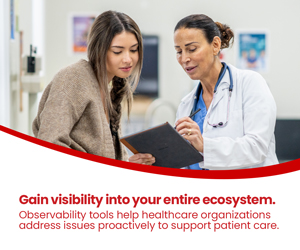Addressing IT Staff and Skills Shortages
With organizations short-staffed, they receive many alerts, which can lead to burnout. They may also struggle to keep pace with the complexity of modern IT environments. Health systems face a mismatch of skills and underinvestment in IT workforce development, Andriola says.
“Industries like healthcare, which must align compensation with tight operational budgets, often feel the pain more acutely,” Andriola says. “As a result, clinicians and patients depend on reliable, secure digital services, yet IT teams are often stretched thin, facing a constant stream of alerts, siloed tools and fragmented data — all of which contribute to burnout and inefficiencies.”
Pain Points in Healthcare IT Workflows
Healthcare organizations are overwhelmed with many scanning tools and configurations, Lobig says. Some processes are poorly defined, and silos hinder observability efforts.
“Many organizations often have multiple, disconnected monitoring and security tools that only provide a partial view of their environment,” Andriola says. “This increases silos and operational complexity and slows down issue resolution.”
Andriola notes the dangers of downtime in healthcare: “In clinical settings, every second counts, and downtime isn’t just disruptive, it’s potentially dangerous. Whether in the ER, operating room or supporting personalized care, healthcare systems must operate in a real-time, always-on model.”
Observability can simplify complexity in organizations with interconnected digital services, Andriola says.
FIND OUT: What are the top five healthcare challenges solved by observability tools?
How Observability Provides Visibility To Overcome Blind Spots
Observability tools provide an application topology to help organizations understand the interconnectivity of systems and network endpoints and map information flow. With the data that observability tools provide, organizations can quarantine vulnerabilities, Lobig suggests.
“In particular, the ability to understand information flows, service flows and quarantine applications and/or end points based on those vulnerability vectors is something observability tools can do,” he explains.
To alleviate the “blind spots” of traditional monitoring applications, observability tools provide a “single source of truth” and end-to-end visibility. They tighten governance across cloud, edge and hybrid environments, as well as integrate data platforms and large language model (LLM) workloads, Andriola says.
“More advanced observability platforms unify data pipelines, security telemetry and business analytics into a single stream, enabling consistent, trustworthy insights at scale,” he explains. “These tools help teams understand how data flows across silos and through analytical layers, building confidence in both operational and strategic decision-making.”
Click the banner below to read the recent CDW Cybersecurity Research Report.














